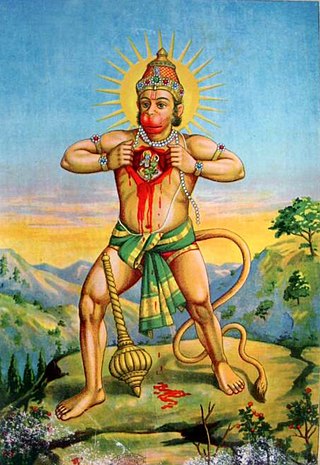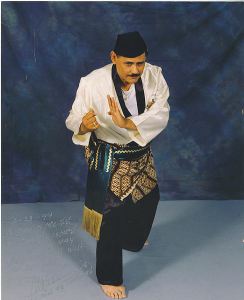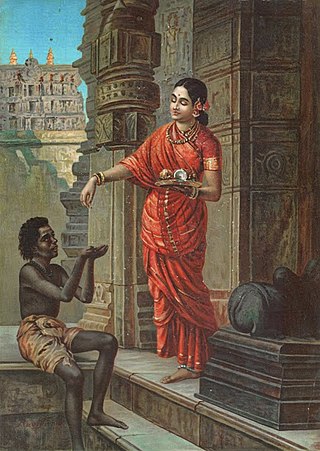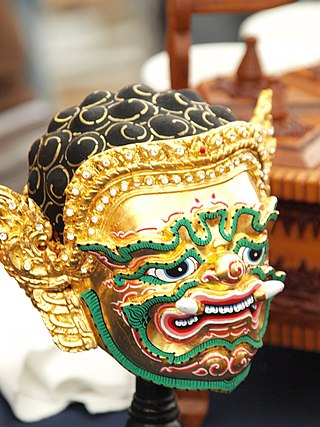
The Ramayana, also known as Valmiki Ramayana, as traditionally attributed to Valmiki, is a smriti text from ancient India, one of the two important epics of Hinduism known as the Itihasas, the other being the Mahabharata. The epic narrates the life of Rama, the seventh avatar of the Hindu deity Vishnu, who is a prince of Ayodhya in the kingdom of Kosala. The epic follows his fourteen-year exile to the forest urged by his father King Dasharatha, on the request of Rama's stepmother Kaikeyi; his travels across forests in the Indian subcontinent with his wife Sita and brother Lakshmana; the kidnapping of Sita by Ravana, the king of Lanka, that resulted in war; and Rama's eventual return to Ayodhya along with Sita to be crowned king amidst jubilation and celebration.

Hanuman, also known as Maruti, Bajrangabali, and Anjaneya, is a deity in Hinduism, revered as a divine vanara, and a devoted companion of the deity Rama. Central to the Ramayana, Hanuman is celebrated for his unwavering devotion to Rama and is considered a chiranjivi. He is traditionally believed to be the spiritual offspring of the wind deity Vayu, who is said to have played a significant role in his birth. In Shaiva tradition, he is regarded to be an incarnation of Shiva, while in most of the Vaishnava traditions he is the son and incarnation of Vayu. His tales are recounted not only in the Ramayana but also in the Mahabharata and various Puranas.

Silat Melayu, also known as Seni Persilatan Melayu or simply Silat, is a combative art of self-defence from the Malay world, that employs langkah ('steps') and jurus ('movements') to ward off or to strike assaults, either with or without weapons. Silat traced its origin to the early days of Malay civilisation, and has since developed into a fine tradition of physical and spiritual training that embodies aspects of traditional Malay attire, performing art and adat. The philosophical foundation of modern Malay Silat is largely based on the Islamic spirituality. Its moves and shapes are rooted from the basis of Silat movements called Bunga Silat, and Silat performances are normally accompanied with Malay drum assembles.

In Hinduism, Vanara are either monkeys, apes, or a race of forest-dwelling people.

Kecak, alternate spellings: kechak and ketjak), known in Indonesian as tari kecak, is a form of Balinese Hindu dance and music drama that was developed in the 1930s. Since its creation, it has been performed primarily by men, with the first women's kecak group having started in 2006. The dance is based on the story of the Ramayana and is traditionally performed in temples and villages across Bali, Indonesia.

PataniDarussalam is a historical region and sultanate in the Malay Peninsula. It includes the southern Thai provinces of Pattani, Yala (Jala), Narathiwat (Menara), and parts of Songkhla (Singgora). Its capital was the town of Patani.

The karambit or kerambit, kurambik or karambiak is a small curved knife resembling a claw, associated with the Malays in Minangkabau of West Sumatra, Indonesia. The karambit is one of the weapons commonly used in pencak silat and Filipino martial arts.

The Ramakien is one of Thailand's national epics. It is a Thai version of the ancient Indian epic Ramayana, and an important part of the Thai literary canon.

Pendekar, Pandikar or Pandeka is a Malay word to reference or address a warrior who mastered martial arts, particularly silat. Not all masters carry the title; it must be either officially bestowed by royalty or unofficially by commonfolk. The latter is more common today, especially outside Southeast Asia. Today, the title is often adopted by the founder of a new style. Parallels can be drawn to the chess term grandmaster since the title of Pandeka is the highest possible rank of a practitioner of the Malaysian martial art silat.

Ramcharitmanas, is an epic poem in the Awadhi language, composed by the 16th-century Indian bhakti poet Tulsidas. It has many inspirations, the primary being the Ramayana of Valmiki.

Mandodari was the queen consort of Ravana, the king of Lanka, according to the Hindu epic Ramayana. The Ramayana describes her as beautiful, pious, and righteous. She is extolled as one of the Panchakanya, the recital of whose names is believed to dispel sin.

Sita, also known as Siya, Janaki and Maithili, is a Hindu goddess and the female protagonist of the Hindu epic Ramayana. Sita is the consort of Rama, the avatar of god Vishnu, and is regarded as an avatar of goddess Lakshmi. She is the chief goddess of the Ramanandi Sampradaya and is the goddess of beauty and devotion. Sita's birthday is celebrated every year on the occasion of Sita Navami.

Yama Zatdaw, unofficially Myanmar's national epic, is the Burmese version of the Ramayana and Dasaratha Jataka. There are nine known pieces of the Yama Zatdaw in Myanmar. The Burmese name for the story itself is Yamayana, while zatdaw refers to the acted play or being part of jataka tales of Theravada Buddhism.

Pencak silat is an umbrella term for a class of related Indonesian martial arts. In neighbouring countries, the term usually refers to professional competitive silat. It is a full-body fighting form incorporating strikes, grappling, and throwing, in addition to weaponry. Every part of the body is used and subject to attack. Pencak silat was practiced not only for physical defense but also for psychological ends. There are hundreds of different pencak silat styles and schools which tend to focus either on strikes, joint manipulation, weaponry, or some combination thereof.
Hikayat Seri Rama is the Malay literary adaptation of the Hindu Ramayana epic in the form of a hikayat. The main story remains the same as the original Sanskrit version but some aspects of it were slightly modified to a local context such as the spelling and pronunciation of names. Numerous branch stories had also been developed as accretions to or extensions of this epic with the upgrading of minor characters to major ones, or the invention of totally new characters. For example, Malay writers and storytellers have produced variations in which Laksmana (Lakshman) plays a larger role, sometimes becoming more important than Rama the elder prince much like the Lao Phra Lak Phra Lam. Rama, although righteous and virtuous, was perceived to be weak and his character is often moved to the background while the younger Laksmana is admired for his courage and willingness to react decisively.

Seni Gayong is a style of silat from Malaysia. It was the first martial arts association to be registered in the country, and is now the biggest and most internationally known Malaysian silat discipline. Gayong is overseen by the Pertubuhan Silat Seni Gayong Malaysia (PSSGM) or the Malaysian Silat Seni Gayong Organisation. This organisation is currently led by Dato' Ismail Jantan. While it is most popular in Malaysia and Singapore, there are also branches in Vietnam, Australia, France, Kuwait, Tunisia, Britain, and the United States.

Silat is the collective term for a class of martial arts from the Nusantara and surrounding geocultural areas of Southeast Asia. It is traditionally practised in Brunei, Indonesia, Malaysia, Singapore, Southern Thailand, Southern Philippines and Southern Vietnam. There are hundreds of different styles (aliran) and schools (perguruan) which tend to focus either on strikes, joint manipulation, weaponry, or some combination thereof.

Virādha is minor character from the Aranya Kanda of the Ramayana. He is a rakshasa living in Dandaka forest who briefly kidnaps Sita in an episode that has been described as "strongly [prefiguring Sita's] later abduction by Ravana, the central event of the book and the pivotal event of the epic." Rama and Lakshmana begin to battle the monster, but though they shoot it with many arrows, the arrows pass straight through him and leave him unharmed.
The monster reveals that he has a boon from Brahma which makes him invincible to weapons. So, the brothers kill the rakshasa by first breaking his arms, then burying him alive in a grave. When the monster's arms are broken, he begins to praise the brothers for liberating him: he had, in a previous life, been a celestial being named Tumburu, and had been cursed by Kubera to live as a fearsome monster until he be killed by Rama. The brothers bury him, and he apparently goes back to his former celestial abode.

Listed here are the weapons of pencak silat. The most common are the machete, staff, kris, sickle, spear, and kerambit. Because Southeast Asian society was traditionally based around agriculture, many of these weapons were originally farming tools.

Trijata is a rakshasi (demoness) in the Hindu epic Ramayana who is assigned the duty of guarding Sita who was kidnapped by the demon-king of Lanka Ravana. In later adaptions of Ramayana, Trijata is described as a daughter of Vibhishana, the brother of Ravana.


















